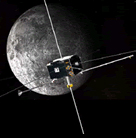Instruments
Caveats
Removing of Spin Modulation (from Le Contel et al., 2008)
Calibration of an SCM mounted onboard a spinning spacecraft with a spin frequency in the antenna bandwidth such as THEMIS probes requires additional steps compared with a laboratory calibration. Indeed, the components of the DC magnetic field perpendicular to the spin axis are measured as a sinusoid with a large amplitude at the spin frequency. Since this DC field (~100 nT) is about 100 times larger than the wave amplitude (< 1 nT), it has to be removed from the raw signal before calibration to avoid undesirable effects. Furthermore, the spinning motion at fs (fs being the spin frequency) introduces a Doppler shift. A circularly polarized magnetic wave turning in the same direction as the spin is not detected because its apparent frequency becomes null. Therefore search coils mounted onboard a spinning spacecraft are not able to fully restitute spin-plane fluctuations with frequencies around the spin frequency. This also means that the sensitivity of the experiment at low frequency depends on the polarization of the waves with respect to the spin axis.
Practically, it is recommended before analyzing waves in a fixed frame (DSL, GSE, GSM) to low-pass filter the data at a minimum frequency higher than the spin frequency; typically fmin could be fixed to the sum of the spin frequency fs and the cut-off frequency fc (the cut-off frequency corresponds to the lower limit of the bandwidth).
Spurious Noise Reduction Process (from Le Contel et al., 2008)
Data analysis during commissioning showed that two types of noise with unexpectedly high amplitudes were present in the SCM waveform data:
First, the power system produces a tone at twice the spin frequency (fs=1/3 Hz) and its harmonics. As expected, the level of these tones decreases during eclipse period.
Second, tones at 8 and 32 Hz, and their harmonics, were found to dominate the spectrum at higher frequencies. Fortunately,
both types of spurious noises are locked in phase and are relatively constant in amplitude. Spin tones are locked to the
spin phase whereas the 8/32 Hz tones are phase locked with the onboard 1s instrument clock. Thanks to this property, a
superposed epoch analysis (SEA) can be applied to the data to reduce the level of these two types of phase-locked noise.
The spurious noise reduction process can be summarized as:
(1) First: An SEA with an average window equal to a multiple of the spin period;(2) Second: An SEA with an averaging window equal to a multiple of 1s.
The noise reduction process has been implemented in the current THEMIS software; two versions of the noise reduction
routine are available and can be activated (or not) in the SCM calibration routine by fixing the keyword clnup_author
(clnup_author='ole' by default or can be 'ccc'). Basically, they give the same results but algorithms are slightly different
(see code sources for more details). Different levels of noise reduction can be selected for each version by using specific keywords
(cleanup='spin' for only spin tone cleanup or 'full' for spin tones and 8/32 Hz cleanup). Note that the duration in seconds of
the first and second averaging windows can be fixed by the keywords wind_dur_spin and win_dur_1s respectively.
In case of large spikes in the waveform that would not come from the two sources listed above, it is recommended to switch off the spurious noise reduction process and look at the raw data first. As the noise reduction process is based on the subtraction of the averaged regular noise, any isolated large spike will result in an erroneous estimate of the average regular noise.






